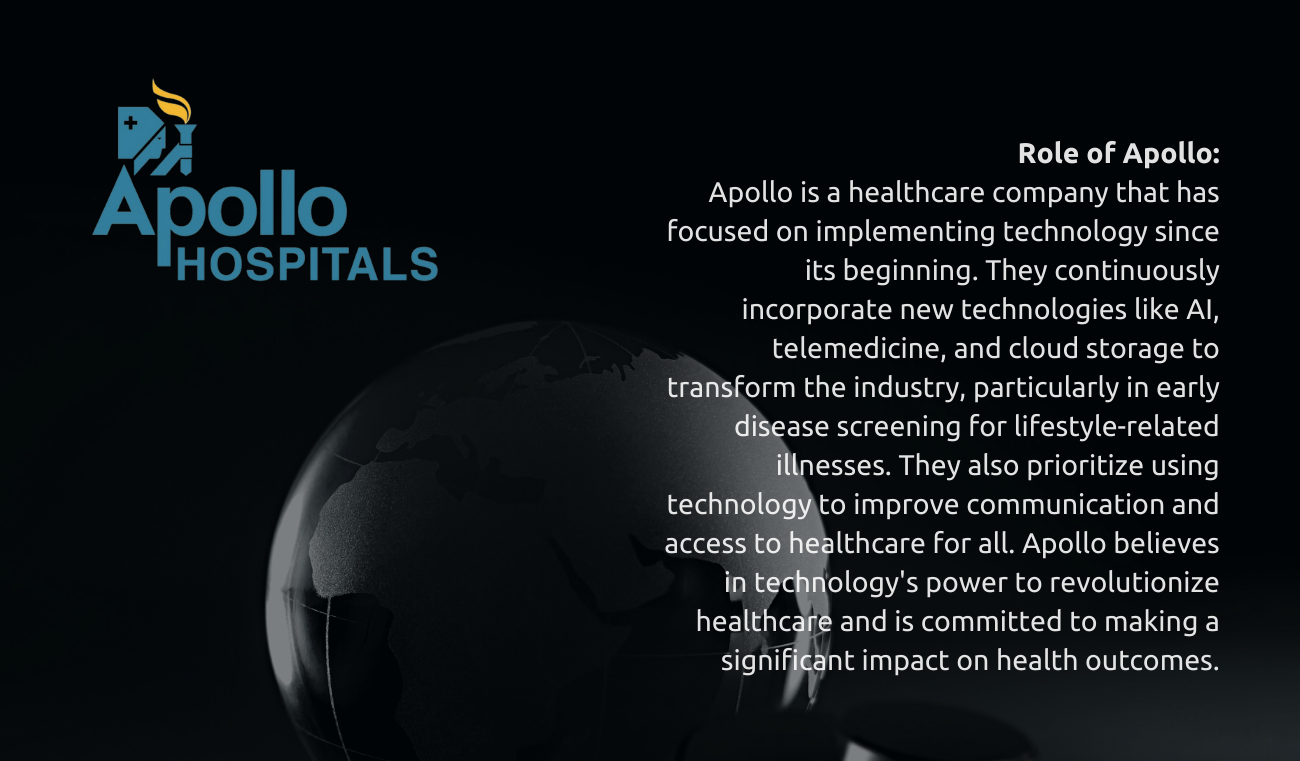Strides Made-Successful Implementation of Technology at Scale: Learnings & Solutions
Read the Magazine in PDF
Our telemedicine network has come a long way in 22 years - from a point-to-point system to a 24/7 accessible digital platform.
By - Dr Sangita Reddy
Abstract
This article discusses the strides made in implementing technology in healthcare in India, with a focus on Apollo’s commitment to using technology to improve the healthcare experience for patients. The article covers various initiatives and technologies adopted by Apollo, including telemedicine, digitalization, AI, and cloud data storage. The article also talks about the Universal Healthcare Identifier (UHCI) and the Patient Generated Account Tour (PGA Tour), which are digital solutions used to facilitate patient movement between different healthcare facilities and enable the seamless transfer of medical records. This will also highlight the importance of communication between patients and doctors and the potential of technology to revolutionize healthcare. In conclusion, this will discuss the deployment of telemedicine, which has transformed from satellite-based to point-to-point and is now a digital platform that is accessible 24/7.
Introduction
India has a chance to transform healthcare and become a leader in cutting-edge and innovative solutions. The country’s dedication to closing disparities, eradicating inequalities, and making healthcare accessible to every household and family could position India as a role model for other nations.
This was exemplified during the recent public health emergency, where the country’s collaborations, creativity, and technology enabled it to administer over two crore vaccinations quickly and effectively.
The integration of technology into healthcare is bringing together two of India’s strengths, its skilled doctors and engineers, to serve the needs of its 1.4 billion people. Real-time tracking of vaccination data is just one example of how technology is being used to improve healthcare in India. With continued investment in technology and collaborations between the healthcare and technology industries, India has the potential to be a global leader in transforming healthcare. Its success in administering a large number of vaccinations during the recent health crisis demonstrates its potential to lead the way in deploying technology for better healthcare outcomes, leveraging its history of producing great doctors and engineers.
Approaching communication through the integration of individuals and technology
The enthusiasm for utilizing technology to improve healthcare provides an overview of some recent advancements and efforts aimed at enhancing the healthcare industry. Specifically, the passage mentions the implementation of the Universal Healthcare Identifier (UHCI), which is a digital identifier used to facilitate patient movement between different healthcare facilities. This identifier was introduced 14 years ago and has been adopted by numerous hospitals and healthcare centres. The UHCI is currently being integrated into the national digital health policy, which will allow for broader implementation and utilization.
The system has a Patient Generated Account Tour (PGA Tour) which includes over 14 million patients. This feature enables the seamless transfer of medical records, providing doctors and other care team members with important patient information. This technology allows an endocrinologist treating a patient with diabetes to access the patient’s records and thus, making it easier to diagnose and treat the condition. The information is also available to other healthcare professionals such as dieticians, exercise therapists, and care counsellors to ensure a comprehensive approach is taken in managing the patient’s health.
Overall, the commitment to using technology to improve the healthcare experience for patients and create a healthier community is evidenced by these initiatives. With the implementation of digital solutions, one can eliminate barriers and make healthcare more accessible and efficient.

Is it punishment programs that enhanced the way we treat patients?
From the beginning, we have been deeply committed to utilizing technology to enhance healthcare. This dedication is exemplified by our numerous initiatives, including our initial trial system, our collaboration with ISRO to establish India’s first telemedicine network in 2000, and our emphasis on virtual care and digitalization. As the amount of data in the healthcare sector continues to expand, the significance of employing technology has become increasingly apparent. With genetic testing becoming more common and the prevalence of non-communicable illnesses on the rise, early detection and intervention have become more critical than ever before.
To improve the quality of healthcare services, we have implemented a unique healthcare identifier across all our systems, enabling the seamless flow of information and care across hospitals, clinics, and other care facilities. We introduced this concept over 14 years ago, and it has been widely adopted by others and is now being implemented on a national level. Over the past 22 years, we have made significant progress in our telemedicine network. Initially, it was a point-to-point system, but it has now evolved into a digital platform accessible 24/7. We also operate not-for-profit primary healthcare centres for the government, which integrate with our telemedicine network, providing access to specialists for patients and empowering primary care doctors with the latest information and clinical decision support systems. Our initiatives have produced encouraging results, with 85% of subscribers reporting a decrease in their blood sugar levels within 90 days. This demonstrates the tangible impact of our efforts on patients and reflects our dedication to providing high-quality healthcare services to all.
Telemedicine and AI in Healthcare: Improving Patient Care
For 22 years, telemedicine has transformed from satellite-based to point-to-point and is now a digital platform that is accessible 24/7. This platform allows doctors from various nursing homes to provide telemedicine services to patients, and it also supports primary healthcare centres for the government on a not-for-profit basis. The deployment of telemedicine has given primary care doctors in these centres access to a clinical decision support system and a learning model that enables them to offer the latest information on treating patients.
The primary goal of telemedicine is to establish a continuum of care that considers the patient’s journey from their perspective. This approach eliminates the need for patients to repeat their medical history and carry their reports from one doctor to another. By utilizing telemedicine, 83% of patients can receive treatment in their villages, without having to travel to large hospitals. This technology effectively erases geographical boundaries and alleviates the burden on major hospitals. Telemedicine encompasses various aspects, such as the dispensation of medicine and utilizing phenotype to obtain second opinions, which allows patients to receive treatment in their local environment.

The integration of AI is the next phase in telemedicine, as it can anticipate health risks and enable doctors to operate at their highest level of proficiency. Additionally, chatbots and healthcare professionals who have undergone six months of training can work with patients to enhance compliance and optimize patient care. In summary, the application of telemedicine and AI is transforming the healthcare industry and advancing patient care. By delivering a continuum of care, decreasing the burden on major hospitals, and empowering healthcare workers, telemedicine and AI are contributing to the development of a healthier community and country.
Revitalizing Healthcare through Omnichannel Platforms in India
In India, the healthcare industry is experiencing a significant transformation due to the integration of technology. Telemedicine platforms, clinical intelligence engines, connected ambulances, and camera-based equipment are improving healthcare and expanding medical services to a broader population. Herein, this discusses the current advances in the Indian healthcare industry and the potential for further growth. The healthcare platform in India already has over 40 million users, bringing the country closer to achieving universal healthcare. The platform covers 19,000 PIN codes and combines physical and virtual elements to provide patients and doctors with a seamless omnichannel experience. The Hitchin system, a remote patient monitoring system, is also integrated into the platform, reducing the workload of healthcare workers and freeing them to focus on other areas of care. One significant benefit of the telemedicine platform is that patients can receive medical care from the comfort of their homes, making it especially useful for individuals in rural areas or those unable to travel. Additionally, doctors can remotely follow up with patients to ensure they receive appropriate care and their health is monitored.
The healthcare industry is being transformed by the deployment of AI and chatbots, which can predict health risks and help doctors provide optimal care. Healthcare workers who have undergone six months of training can also use these tools to ensure patients comply with their treatment plans. Besides technological progress, the healthcare industry is also concentrating on prevention and knowledge sharing to create a healthier and happier world. The development of the telemedicine act has facilitated this progress, and we need to build on these foundations. Standards are crucial, and we must work together to implement India’s standards and SNOMED to guarantee that healthcare transformation occurs at the local level. This will protect healthcare workers, doctors, and patients and ensure that everyone receives the best possible care. In summary, the advances in the Indian healthcare industry are promising and could revolutionize medical service delivery. Collaborative efforts and knowledge sharing will help create a healthier world. Technology integration, such as telemedicine platforms, clinical intelligence engines, and AI, is key to this transformation, and we must continue to focus on these areas to achieve universal healthcare.
Conclusion
In conclusion, India has demonstrated that it has the potential to become a global leader in transforming healthcare through the integration of technology. The success of India’s recent efforts in administering vaccinations during the public health emergency has exemplified its ability to leverage technology to improve healthcare outcomes. Apollo’s dedication to implementing technology in healthcare has also been highlighted. The company has continuously adopted new technologies to revolutionize healthcare. The utilization of telemedicine and AI in healthcare has transformed the industry and has led to improved patient care. Overall, the integration of technology into healthcare is a crucial step in closing disparities and eradicating inequalities in India’s healthcare system. Through continued investment and collaborations, India has the potential to become a role model for other nations in using technology to improve healthcare.




